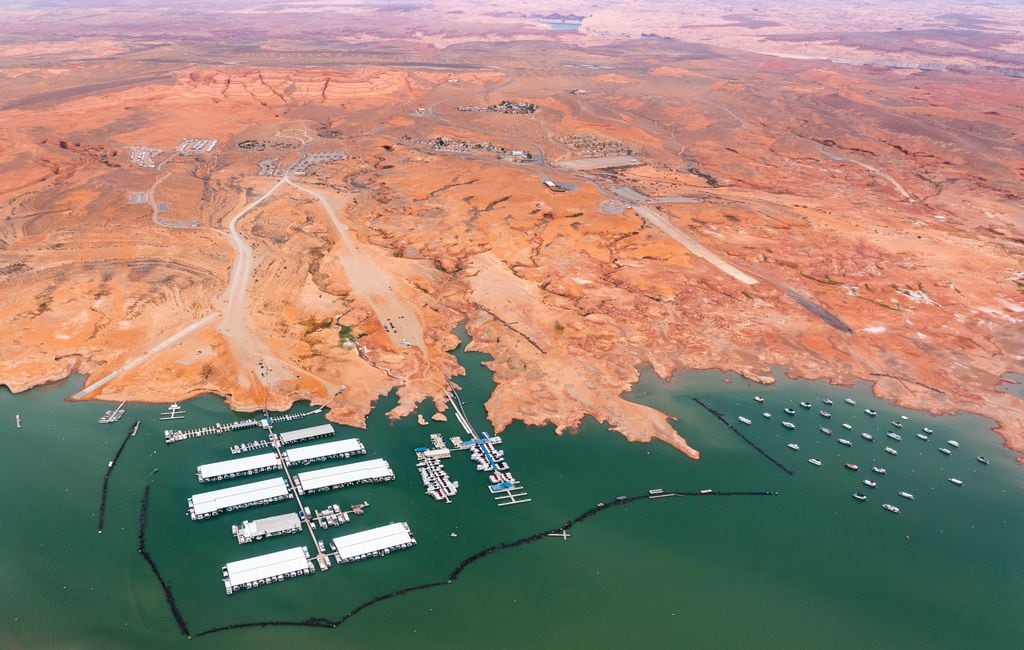
As water managers across the Colorado River basin are scrambling to slow the declining levels in Lake Powell and Lake Mead, a coalition of groups that supports motorized recreation on the reservoir are calling for even deeper water cuts to boost the reservoir.
According to a report released Wednesday by the BlueRibbon Coalition and PowellHeadz, reviving reservoir recreation on Lake Powell may require reducing water use across the basin by 30%, or by nearly 4 million acre-feet of water, starting next year.
All but two of the boat ramps along Lake Powell’s 180-mile length are currently closed, and the ramp at Utah’s Bullfrog Marina, which was extended last year due to low water levels, may be closed as soon as September, according to the National Park Service.
John Rickenbach, a California-based environmental consultant who authored the report for the “Fill Lake Powell” campaign, said that levels in Lake Powell need to be stabilized in order to protect hydropower generation, recreation and water supply.
The Colorado River basin currently is experiencing a 22-year megadrought that has been linked to climate change, and water use has outpaced the amount of water available in the river during that time.
“Unless there are big cutbacks by everybody,” Rickenbach said, “then you just don’t have a system where the Bureau [of Reclamation] can operate things properly and for the benefit of everybody.”
The advocacy groups backing the campaign are pushing to refill Lake Powell to 3,588 feet in elevation in five years, a level at which most of the park’s recreational facilities and boat ramps would be operational. The reservoir is currently at 3,534 feet and could fall below 3,500 feet by next year, endangering hydropower generation at the Glen Canyon Dam.
Rickenbach’s analysis shows that even with average winter snowpack and runoff conditions — which are increasingly unlikely, according to numerous climate models — unprecedented water use reductions would be necessary to meet the coalition’s goal.
If runoff in the near future is closer to the 21st-century average, which is down nearly 20% compared to the previous century, bringing Lake Powell up to the group’s target elevation would require reducing water use in the basin by 30% for the next two years and then 25% after that. If reductions don’t begin until 2024, the proposal could become much more difficult to implement.
The Bureau of Reclamation has identified the need to plan for cuts of a similar magnitude to those outlined in the Fill Lake Powell report. The federal agency gave states in the river basin a deadline of Monday, Aug. 15, to present plans to reduce water use by between 2 and 4 million acre-feet, 16% to 32% of current use.
But with 40 million people in seven states, 30 Native American tribes and Mexico dependent on Colorado River water, asking users to make additional cuts to protect houseboating on Lake Powell is a big ask.
“I think this report shows why we need to take action now,” said Dan Beard, who served as commissioner of the Bureau of Reclamation Commissioner in the Clinton administration and has been critical of the agency.
Beard said the report highlights the difficulty of managing both Lake Powell and Lake Mead under megadrought conditions.
“I compliment them on their analysis,” Beard said, “but this report clearly shows how difficult politically and economically it will be — impossible as far as I’m concerned — to artificially prop up Lake Powell. We need to go in another direction, and that’s to lower the levels of Lake Powell, abandon Glen Canyon Dam and save Lake Mead.”
Lake Mead, the nation’s largest reservoir, generates more hydropower than Lake Powell, attracts more visitors each year and is capable of storing more water.
The water supply needs from Lake Mead far surpass those from Lake Powell, Beard said.
Rickenbach said his report looked at stabilizing levels in both Lake Mead and Lake Powell, and he dismissed calls to modify the dam to restore Glen Canyon, a long-time rallying cry by some environmental advocates.
“It would be a great thing if there never was a Glen Canyon Dam,” Rickenbach said, “but because there is a Glen Canyon Dam and there has been for 60 years almost, and people rely on that — millions of people, for a lot of reasons — that’s the baseline you start with before you start going another direction, in my view.”
Lake Powell generated $420 million in economic activity in 2019 when the reservoir was 100 feet higher than this year’s low in April. Visitation has dropped with the water levels, falling from 4.2 million visitors in 2019 to 3.1 million in 2021, but a park service study found economic activity only dipped slightly last year to $410 million.
Farmers in Yuma, Ariz., by comparison, have proposed being paid $1,500 per acre-foot of water that they don’t use to protect reservoir levels, the LA Times reports. By that metric, 4 million acre-feet in cuts would cost $6 billion.
And water-based recreation is not the only economic driver in the Lake Powell area. In a news release last week, the park service said land-based recreation in Glen Canyon National Recreation Area has “increased exponentially” in recent years, including in the free-flowing section of the Colorado River below the Glen Canyon Dam.
The Bureau of Reclamation and water managers throughout the basin have spoken about the need to keep Lake Powell above the cutoff for hydropower generation at 3,490 feet in elevation and they’ve developed guidelines for a target elevation of 3,525 feet.
The park service announced last week that it is exploring a $26 million plan to move boat ramps and marinas in Bullfrog to a deeper part of the reservoir, which would allow them to be used as low as 3,450 feet in elevation. The only ramp currently open on the reservoir’s south end near Page, Ariz., can be extended to 3,490 feet in elevation the level at which hydropower generation would cease.